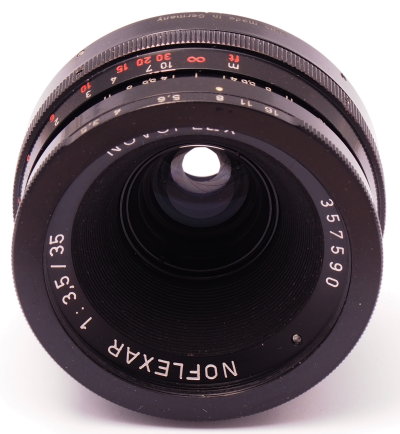Novoflex Noflexar 35 mm f/3.5 
The Noflexar 35 mm (above) is unusual in being designed as a macro lens. In addition to a rather short focusing helicoid that allows focus between infinity and 0.35 m, it is equipped with a built-in extension tube that allows the lens to be extended by four click-stops separated from each other by 3.5 mm. The focusing helicoid is used to focus within each click-stop. The above image shows a partly disassembled Noflexar 35 mm with the click-stops of the extension mechanism visible as machined grooves. However, this idea works better in theory than in practice. The extension range of the helicoid does not completely cover the focusing range between adjacent click-stops (especially if the focus of the lens has been recalibrate to allow infinity focus on a camera without an IR- and UV-blocking internal filter). This leaves small gaps inaccessible in the focusing range. In addition, when the lens is extended by one or more click-stops, strong ambient illumination can leak through the extension mechanism and cause substantial flare and IR contamination of recorded UV images. This lens is also characterized by a small front optical element, deeply recessed within the hood-like front of the lens barrel. The odd design of the aperture ring means that the front filter mount rotates together with the aperture ring. A further characteristic in some types of mounts (foremost M42) is that the rear element projects from the rear of the barrel and is easily damaged by placing the lens rear on a table. This is why it was necessary to use a rear lens cap in the above picture. The specimen at the left shows part of a lens originally in Exakta mount, which has a more recessed rear element. This lens seems to have been first used in UV photography several years ago by Vivek Iyer. The Noflexar 35 mm is at present both expensive and scarce. I used to recommend it as a good lens for UV photography of relatively low focal length. Because of the unrealistically high prices currently being asked, it is no longer my recommended choice as a first lens to start out in UV photography with mirrorless cameras. According to Klaus Schmitt, the Staeble Lineogon 35 mm f/3.5 in M39 mount (albeit with a higher registration distance than the Leica M39/L39) uses the same optics as the Noflexar 35 mm. It is usually much cheaper than the Noflexar, and better for use on a focusing helicoid or bellows because of its smaller barrel and less recessed front element. The Noflexar 35 mm f/3.5 can be seen here mounted on a Micro 4/3 camera and with its built-in extension tube fully extended. Samples of UV pictures shot with this lens are available at the same link. The UV performance of this Noflexar lens is discussed more in detail here. |